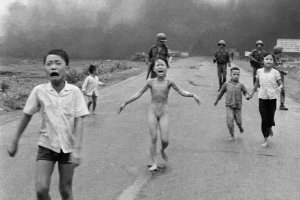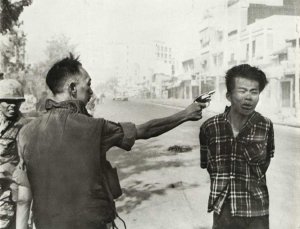As Forrestal headed to port for repairs, McCain volunteered to join the undermanned VA-163 "Saints" squadron on board the USS Oriskany.[94]
This carrier had earlier endured its own deck fire disaster[95] and its squadrons had suffered some of the heaviest losses during Rolling Thunder. The Saints had a reputation for aggressive, daring attacks, but paid the price:[96] in 1967, one-third of their pilots were killed or captured, and all of their original fifteen A-4s had been destroyed.[96]
After taking some leave in Europe and back home in Orange Park, Florida,[97] McCain joined Oriskany on September 30, 1967,[96] for a tour he expected would finish early the next summer.[98] He volunteered to fly the squadron's most dangerous missions right away, rather than work his way up to them.[99]
During October 1967, the pilots operated in constant twelve-hour on, twelve-hour off shifts.[100] McCain would be awarded a Navy Commendation Medal for leading his air section through heavy enemy fire during an October 18 raid on the Lac Trai shipyard in Haiphong.[101] On October 25, McCain successfully attacked the Phúc Yên Air Base north of Hanoi through a barrage of anti-aircraft artillery and surface-to-air missile fire; credited with destroying one aircraft on the ground and damaging two, the raid would garner him the Air Medal.[101] Air defenses around Hanoi were at this point the strongest they would be during the entire war.
On October 26, 1967, McCain was flying his twenty-third mission, part of a twenty-plane strike force against the Yen Phu thermal power plant in central Hanoi[104][105] that previously had almost always been off-limits to U.S. raids due to the possibility of collateral damage.[102] Arriving just before noon, McCain dove from 9,000 to 4,000 feet on his approach;[106] as he neared the target, warning systems in McCain's A-4E Skyhawk alerted him that he was being tracked by enemy fire-control radar.[107] Like other U.S. pilots in similar situations, he did not break off the bombing run,[62] and he held his dive until he released his bombs at about 3,500 feet (1,000 m).[108] As he started to pull up, the Skyhawk's wing was blown off by a Soviet-made SA-2 anti-aircraft missile fired by the North Vietnamese Air Defense Command's 61st Battalion,[102][106] commanded by Captain Nguyen Lan[106] assisted by fire control officer Lieutenant Nguyen Xuan Dai.




